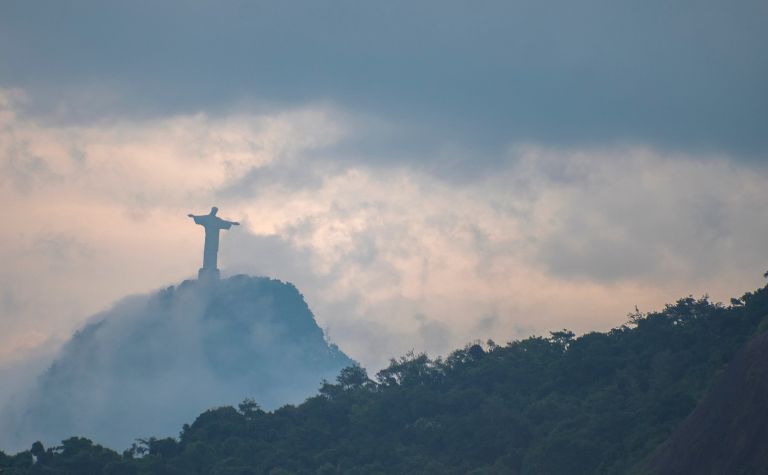Christ the Redeemer is a colossal monument that is breathtaking to behold. The statue stands high on the sacred Carvacado mountain overlooking Rio de Janeiro and has become the city’s symbol.
The statue was built in nine years, from 1922 to 1931. It was designed by Heitor da Silva Costa, a Brazilian engineer, and artist Carlos Oswald. Paul Landowski, a Polish-French sculptor, created the statue in clay before it was transported to Brazil and rebuilt in concrete.
The statue was designed in the art deco style, distinguished by its simplicity, symmetry, and use of manufactured materials such as concrete, which was used to make it. The figure of Christ with his arms wide open is an eternal symbol of peace and redemption, and the story of its construction is as fascinating as the sight of this magnificent monument.
Also see Why Was Christ the Redeemer Built? to learn more.

How Much Did the Statue Cost To Build?
The statue cost $250.000 to build in 1931, which equals $4,807,500 in 2022. Most of the money raised for the Christ the Redeemer statue came from the Catholic church and community. [1]
When the idea of building a Christian monument on Corcovado mountain first emerged, which was as early as the 1850s, it was intended to honor Princess Dona Isabel, the daughter of the Emperor of Brazil at the time. The royal family was approached for funding, but the project was never approved.
The intention re-emerged after World War I when Brazil had already become a Republic with the church separated from the state. The Catholic community feared that it would result in people’s lack of godliness, and the idea of building a colossal statue of Christ in Rio de Janeiro was revived.
When the project was proposed again, many Brazilians supported it and signed a petition to have the monument built on Corcovado.
In 1923, a campaign called ”The Monument Week” was announced to raise money for the monument’s construction. It was a massive campaign and was promoted almost everywhere in the city with the help of volunteers.
The second campaign was organized in 1929, followed by a third and final one. Again, many people, mostly Catholics, contributed to the cause, making it possible for the project to advance.
Also see Who Built the Christ the Redeemer Statue? to learn more.

How Long Did It Take To Build?
It took nine years to build the statue. Construction started on April 4, 1922, when the first stone was ceremonially laid, and ended on October 12, 1931, when the statue was officially opened.
Authorities approved the proposal to build a Christ statue on Corcovado with the support of the local people in 1921. The foundation stone was laid the following year, on April 4, 1922, the day of Brazil’s independence from Portugal.
After that, the design competition for the statue project began. Heitor da Silva Costa, a Brazilian engineer, won it. His sketches depicted Christ standing with a large cross next to him and holding a globe in his hand. However, the globe turned out to be confusing for the people, with many mistaking it for a ball or intentionally mocking it.
Carlos Oswald finalized Da Silva Costa’s project by simplifying the design and making it more powerful. Then, he removed the objects and designed a figure of Christ with his arms wide open, transforming his figure into the Christian symbol of the cross.
The design aimed for Christ to face the dawn, and the completed statue looks to Rio’s east, while the left-hand points to the north and the right hand to the south.
The statue’s construction began in 1926. In his Paris studio, Paul Landowski built a 4-meter (13.12 feet) model of the statue. He also made Christ’s head, and hands out of clay in full size, and the pieces were then shipped to Brazil to be built in concrete.
Workers finished the process in 1931 after nine years of hard work, and the monument was officially unveiled on October 12.
Since then, the statue has undergone several renovations and refurbishments, including significant work in 2010, during which workers cleaned it and repaired the surface and inner steel constructions.
Previously, tourists had to climb more than 200 steps to reach the top of the Christ the Redeemer statue. However, panoramic elevators and escalators were eventually built, making them more accessible and pleasant for visitors.
The statue is vulnerable to weather elements and experiences frequent lightning strikes, necessitating regular maintenance. In 2014, lightning damaged the statue’s head and right thumb.
Also see How Tall Is Christ the Redeemer? to learn more.

What Is Christ the Redeemer Made Of?
Christ the Redeemer is made of reinforced concrete and covered with a patchwork of thousands of mosaic soapstone tiles. It’s thought that the construction workers inscribed personal notes behind the tiles before installing them.
After the design was finalized, the engineers and sculptors faced a difficult task. They chose Corcovado mountain because it was a high point within the city limits and because they wanted the statue to be visible from all major Rio locations.
Building a monument of that size required ensuring that the statue was made of solid material capable of supporting Christ’s outstretched arms and withstanding the influence of the weather.
Da Silva Costa, one of the project’s creators, chose concrete as the monument’s material. However, when the steel constructions for the statue were already erected, he was still undecided on its final look.
Da Silva Costa found that concrete looked unappealing, rough, and lacking in elegance. He regarded the construction process as “marching towards an inevitable artistic failure.”
The idea to create an outer shell of tiles for the statue came to Da Silva Costa when he was in Paris. He saw a fountain on the Champs Elysees that was covered in a silver mosaic and took his inspiration from it. [2]
Soapstone was chosen as the material for the tiles covering Christ the Redeemer. Aleijadinho, a Brazilian sculptor from the 18th century, used it for monuments, fountains, and other sculpture works. [3]
The way his soapstone works were preserved at the turn of the twentieth century demonstrated the material’s durability. According to Da Silva Costa, it was the first time that mosaic was used to decorate a sculpture.
Also see Where Is the Christ the Redeemer Statue? to learn more.
Conclusion
It took nine years to complete the ambitious project of Christ the Redeemer. Yet, today, it’s considered one of the seven wonders of the modern world.
References:
[1] Source
[2] Source
[3] Source
Related Questions
The life of Jesus Christ continues to fascinate people more than 2,000 years after he walked the earth. The places where he called his disciples, preached about the Kingdom of God, and performed...
The crucifixion of Jesus Christ is one of the most important events in the Bible. Jesus' death on the cross, as well as his resurrection from the dead, are the climactic moments in the New Testament...
